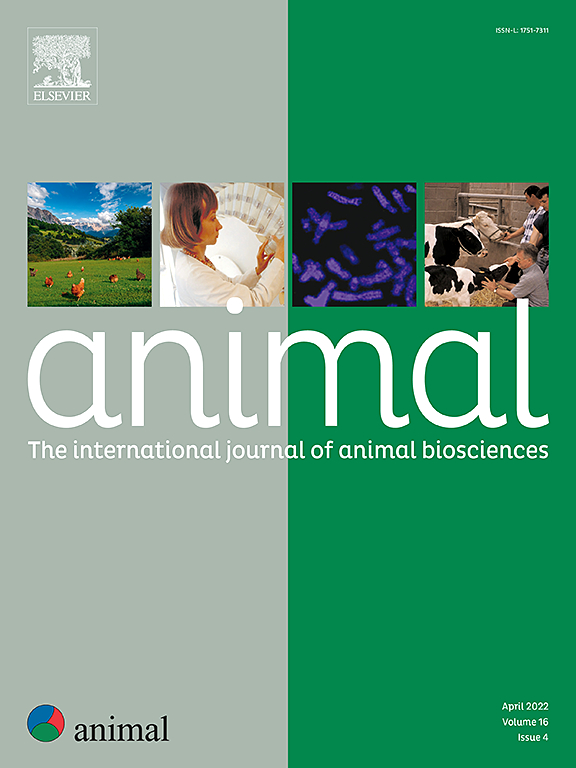能量、氨基酸和矿物质调整后连续三个妊娠期母猪精确饲养对母猪生产性能和骨吸收指标的影响。
IF 4.2
2区 农林科学
Q1 AGRICULTURE, DAIRY & ANIMAL SCIENCE
引用次数: 0
摘要
仅向妊娠母猪提供一种日粮并不能充分覆盖母猪在妊娠期间个体和每日需求的变化。累积的矿物质失衡会降低母猪群的整体生产性能。在哺乳期(骨骼活动发生时)和妊娠期(骨骼应该恢复时),矿物质缺乏尤为严重。矿物过剩影响环境影响和经济成果。本研究旨在评估连续3个繁殖试验周期内调整能量、氨基酸和磷的精密饲喂策略对母猪生产性能、营养平衡、健康和矿物质状况的影响。PF策略涉及在个体水平上根据数量(能量)和质量调整每日膳食供应,包括氨基酸(标准化回肠可消化赖氨酸,SID-Lys)和矿物质(P的表观全消化道消化率,ATTD-P)。授精7 d后,根据胎次、体重和背膘厚度,将2批28头长×大白妊娠母猪分别饲喂两种饲喂策略(PF与按能量需求调整的标准饲粮)中的一种。PF策略是将两种等净能(NE)饲粮(9.0 MJ/kg, 2.6 g/kg ATTD-P,低SID-Lys含量分别为3.3 g/kg或高SID-Lys含量为8.5 g/kg)混合在一个自动喂食器中,直至妊娠第80天。在妊娠最后一个月,额外添加4.0 g/kg ATTD-P日粮,以确保满足母猪对磷的增加需求。相比之下,SF母猪整个妊娠期只饲喂一种饲粮(9.0 MJ/kg NE、2.6 g/kg ATTD-P和4.7 g/kg SID-Lys)。连续三个妊娠期的SID-Lys摄入量为18% (P 0.10)。PF将饲料成本降低至每吨5欧元(0.10便士)。仅在妊娠最后一个月调整磷供应以适应母猪的磷需要量,更好地满足母猪的营养需求,与能量调整的磷供应策略相比,对生产性能没有长期影响,也没有降低骨吸收。本文章由计算机程序翻译,如有差异,请以英文原文为准。
Influence of precision feeding of sows over three consecutive gestations adjusted for energy, amino acids and minerals on sow performances and a marker of bone resorption
Supplying only one type of diet to gestating sows does not sufficiently cover the variability in individual and daily requirements of sows throughout gestation. A cumulative mineral imbalance decreases the overall performance of a sow herd. Mineral deficiency is particularly critical during lactation, when mobilisation of bones occurs, and during gestation, when it should recover. Excess minerals influence environmental impacts and economic outcomes. The objective of this study was to assess the influence of a precision feeding (PF) strategy adjusted for energy, amino acids and P over three consecutive reproductive experimental cycles on sow productive performances, nutrient balances, health and mineral status. The PF strategy involved adjusting daily dietary supplies at the individual level based on quantity (energy) and quality, including amino acids (standardised ileal digestible lysine, SID-Lys) and minerals (apparent total tract digestibility of P, ATTD-P). Seven days after insemination, two batches of 28 Landrace × Large White gestating sows were allocated to one of the two feeding strategies (PF vs a standard feeding strategy with a single diet adjusted on energy requirements (SF)) based on their parity, BW and backfat thickness. The PF strategy consisted of mixing two iso-net energy (NE) diets (9.0 MJ/kg, 2.6 g/kg ATTD-P, with low: 3.3 g/kg or high: 8.5 g/kg SID-Lys content, respectively) in an automatic feeder on an individual and daily basis until day 80 of gestation. During the last month of gestation, an additional diet (4.0 g/kg ATTD-P) was supplied to ensure that the sows’ increased P requirements were met. In contrast, SF sows were supplied only one diet throughout gestation (9.0 MJ/kg NE, 2.6 g/kg ATTD-P and 4.7 g/kg SID-Lys). The SID-Lys intake over three consecutive gestations was 18% (P < 0.001) lower for PF than SF sows without decreasing farrowing performances (P > 0.10). PF reduced feed cost up to 5 €/tonne (P < 0.001). Only during the last week of gestation, daily ATTD-P intake was 1.5 g greater for PF sows than for SF sows (P < 0.001). The feeding strategy did not influence total ATTD-P intake or urinary concentration of C-terminal telopeptide of type I collagen, a bone resorption marker (P > 0.10). Adjusting P supplies to the sows’ P requirements only during the last month of gestation better met their nutritional needs, had no long-term effects on farrowing performances and did not decrease bone resorption compared to the SF strategy adjusted for energy.
求助全文
通过发布文献求助,成功后即可免费获取论文全文。
去求助
来源期刊

Animal
农林科学-奶制品与动物科学
CiteScore
7.50
自引率
2.80%
发文量
246
审稿时长
3 months
期刊介绍:
Editorial board
animal attracts the best research in animal biology and animal systems from across the spectrum of the agricultural, biomedical, and environmental sciences. It is the central element in an exciting collaboration between the British Society of Animal Science (BSAS), Institut National de la Recherche Agronomique (INRA) and the European Federation of Animal Science (EAAP) and represents a merging of three scientific journals: Animal Science; Animal Research; Reproduction, Nutrition, Development. animal publishes original cutting-edge research, ''hot'' topics and horizon-scanning reviews on animal-related aspects of the life sciences at the molecular, cellular, organ, whole animal and production system levels. The main subject areas include: breeding and genetics; nutrition; physiology and functional biology of systems; behaviour, health and welfare; farming systems, environmental impact and climate change; product quality, human health and well-being. Animal models and papers dealing with the integration of research between these topics and their impact on the environment and people are particularly welcome.
 求助内容:
求助内容: 应助结果提醒方式:
应助结果提醒方式:


